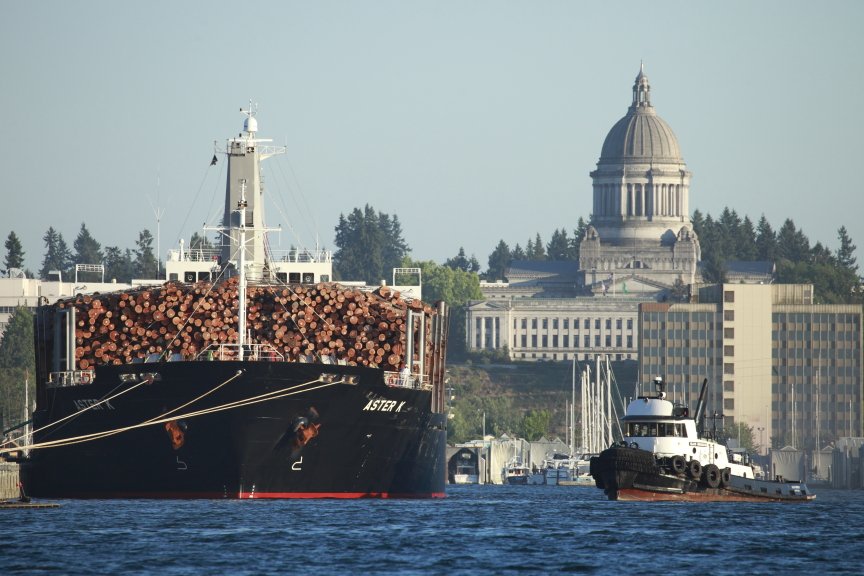Historically, ports have always had a reputation; some as gateways to glamor and adventure, others as gathering places for disreputable characters, and most some combination of both. At the Port of Olympia, Director of Environmental Programs Rachael Jamison is aiming for a different kind of recognition.
“My personal goal is that within the next two to five years, the Port of Olympia is looked to as one of the most sustainable mid-sized ports in the country,” she says. “We do a tremendous amount of work for the environment. I don’t know that the community is aware of everything that is happening here.”
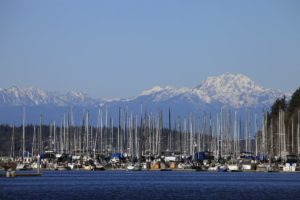
At the Port of Olympia, substantial efforts go beyond what regulatory bodies call for in turning formerly toxic lands into viable parks and sustainable development projects, combating climate change, conserving land and seafront, and developing innovative systems to deal with storm water.
Everything starts with compliance, says Jamison, but it doesn’t end there. The port is regulated by multiple agencies, including U.S. Fish & Wildlife, Washington State Fish & Wildlife, the Department of Ecology, the Olympic Region Clean Air Agency, and more. “All of them have their own suites of standards and regulations that we need to remain cognizant of before we do anything on the ground,” she explains.
On the remediation front, the port has taken on several major sites with legacy contamination and put them to what’s known as higher and better use. In the East Bay, one highly visible project is the site of the Hands On Children’s Museum, which the port made viable for development through a collaboration with the City of Olympia and LOTT Clean Water Alliance.
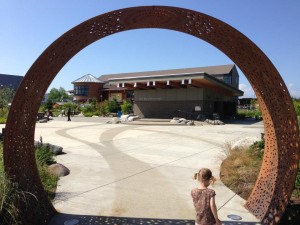
More is coming, says Jamison. “We’re in the final phases of cleaning up lots that comprised the East Bay redevelopment site that will ultimately give rise to a Walker John project. That’s going to include the first multi-family LEED certified building in Thurston County that we’re aware of. It’s exciting stuff.”
The East Bay site epitomizes sustainable redevelopment, Jamison contends. “We’re cleaning up legacy toxics, redeveloping a brownfield, and incenting a green building,” she says. “Additionally, we’ve been working with our developer and his team, and the Center for Sustainable Infrastructure at The Evergreen State College on ways we can build in some innovative energy technologies.”
Across the water, West Bay Park is also a reclaimed former Port site. “A lot of the park is on what used to be Port of Olympia land,” says Jamison. “We did remediation work there and sold it to the city.”
At Budd Bay Inlet, the Port has worked with the Department of Ecology (DOE) to deal with toxic contamination in a project that will be ongoing for several more years. “At this point, we have an data related to where the contamination is and its levels,” she says. “We’re working with the DOE to determine the best remedies to bring those down to levels that are safe for human health and the environment.”
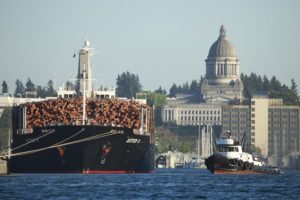
The Port of Olympia has also taken an active role in combating climate change, recently completing a Scope I and Scope II greenhouse gas emissions assessment that included the gas used in port-owned vehicles and the amount of energy consumed in buildings they own and lease out. In February the Port will initiate a Sustainability and Climate Change Action Committee to identify ways the staff can reduce its carbon footprint and engage in meaningful climate change dialogue.
They’re looking for ways to educate and work with their tenants on the issue. “One of the biggest myths, in my opinion, of the last century was that business is always bad for the environment,” says Jamison. “From what we’ve seen, doing good for the environment can be good for business, too.” The port is also collaborating with the City of Olympia on a sea-level rise study.
Although it’s not required by any regulations, the Port has joined several independent organizations that offer third-party certifications in the area of sustainability. They had already received Clean Marina and Clean Boatyard certifications, and recently joined Green Marine, a certification system that evaluates the sustainability of marine terminal operations.
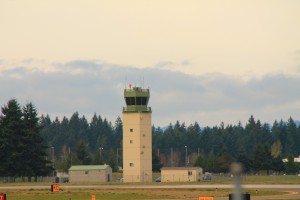
“We do quite a bit of environmental work at the terminal, whether it’s addressing light and noise pollution in innovative ways or having solar panels installed on our warehouse,” says Jamison. “This is a great opportunity for a third-party to come in and tell us how we’re doing.”
Aside from 150 acres in downtown Olympia, the Port also owns nearly 1,000 acres at the Olympia Regional Airport, where they’ve been working with the City of Tumwater on a Habitat Conservation Plan to address endangered species, especially the Mazama Pocket Gopher.
“We’re hoping to have a habitat conservation plan completed within the next two to three years,” says Jamison. “We have convened a fairly large stakeholder group and in 2017 we’ll be having public meetings and engaging the broader public of Thurston County in a dialogue. These are complex planning efforts.”
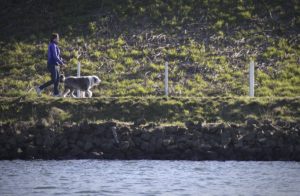
Downtown, the Port has made a nature trail that goes around the peninsula more sustainable. “We have a real superstar in our landscaping group who has reduced our pesticide use by 73% over the last three to five years,” says Jamison. “Integrated Pest Management is the rule of the land, and 70% of the plants planted on the trail are native to our area. It’s nice to me as a citizen of Thurston County to know that when I walk or run that trail, my exposure to any kind of chemical is minimal, and it’s fun and interesting to see Washington’s natural history highlighted in downtown Olympia.”
Most importantly, the Port of Olympia can act as both an economic engine and a model for other communities, Jamison says. “How we steward our resources is important. We’re always looking for creative ways to ensure Thurston County’s economy is robust in a manner that’s environmentally sustainable.”
For more information about the Port of Olympia, visit www.portolympia.com or call 360-528-8000.
Sponsored









































